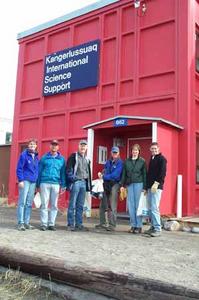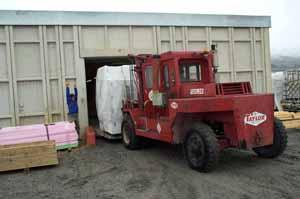29 April, 2003
Do we stay or do we go?
The extreme environments of Greenland affect research in many ways.
First, travel in extreme environments can be held up. Yesterday and
today were days set aside as preparation days. One twin-engine otter
was to fly out today with fuel canisters and empty ice core boxes.
The weather in Kanger was above freezing as it was lightly misting
and at the higher elevations there was a new dusting of snow, however
in higher elevations there were was poor visibility weather that
restricted the Otter’s flights. Often times the clouds are so low
that pilots cannot tell were the ground ends and the atmosphere
begins. This can cause a plane to slam into the ground as the pilots
are landing as they think the ground is still well below them. We
are hoping that tomorrow we will be able to take two trips: one for
gas and boxes and the other for gear and people. If that is
impossible we will hold up in Kanger at least another day.
Second, if any gear fails to work in extreme environments people or
the progress of the research could be jeopardized. Our first two
days of preparation involved setting up tents, making sure stoves
worked, doubling checking sleeping gear such as therma-rests and
sleeping bags, making sure everyone had a thermos and extra water
bottles.
We will use two tents that are called Arctic Ovens. Each tent is
made of very thick material that should keep in any heat that is
produced and then is covered by a fly (tarp) that will keep the wind
and moisture out. One tent is twelve feet by twelve feet and the
other is ten by ten. The smaller tent is the "poop" tent. We will
dig a hole beneath the tent which has a flap were we will set up
toilet seat. Our main driller, Lou, brought along a custom made
cushioned toilet seat so we will be sitting in style. Custom means
that it is made from 2-inch pink hard board insulation. The larger
of the tents will be a cooking and warming tent. We will keep our
Coleman stoves and food in this tent. Each person will also get an
individual tent for sleeping. Finally, we made sure all of the core
boxes and drills were properly organized so that time would not be
wasted in a very cold environment. Yesterday it was -38 degrees
Celsius at the elevation we will be collecting at later this week.
Finally, we spent part of the day discussing communication needs. We
assigned safety and communication protocols. A protocol establishes
who does what in case of an emergency. One of my jobs is to use the
Iridium satellite phone to contact emergency services and then relay
what should be done to other members of my team. Because our main
objective is to collect a core of ice that is about 150m (300 plus
feet) long which is then broken into 1m pieces we took time to
establish a system that everyone would use when handling the ice
cores. Once we are collecting cores I will explain more.
Kangerlussauq (kAnger loo schwack) is an old US military base from
WWII. Because of that there is a very nice airport, indoor swimming
pool, workout facilities, and a golf course. It is the most northern
golf course in the world. I will not get any time to hit the links
on this trip! As for the residential Kanger, it is probably not much
in the eyes of most visitors. Most of the buildings look like large
cement storage warehouses but inside they are quite nice. More
importantly it has running water of which there is not a lack of hot
water. I am staying in the KISS (Kangerlussauq International
Science Support) building, which is similar to a large dormitory.
Down the road is the Polar Bear Inn, which serves breakfast, lunch
and dinner. The first night I was served Musk ox heart with gravy!
Most of the residents are Inuit or Danish. There are approximately
446 residents however the population rises during the summer months
with the military, tourism and scientists. It is usually very dry
here (desert conditions) as there is more evaporation than
precipitation.

Our team in front of KISS

Lou, our head core driller, directing a load that is to be sent by plane to our first test site.
Contact the TEA in the field at
.
If you cannot connect through your browser, copy the
TEA's e-mail address in the "To:" line of
your favorite e-mail package.
|
